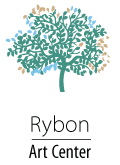First Rybon International Artists' Workshop
Rybon International Artists' Workshop
10 - 23 October 2012 - Tehran, Iran
In Collaboration with Sazmanab Platform and Mohsen Gallery
Open Day:
21 October 2012
The first artist to arrive is Sarah Hatahet, a young talented artist from Jordan. After her the others arrive one by one. Gargi Raina, an established artist from India, Richard Penn, a brilliant painter from South Africa, Yang Jian, a highly experimentalist artist from China, and Ali Cherri, a smart creative visual artist from Lebanon.
The Iranian artists who have been selected with great scrupulosity prove that we have not been wrong. Hamed Rashtian, a prestigious sculptor, Pooneh Oshidari, a smart painter and illustrator, Katayoun Karami, a creative photographer, Mahmoud Mahroumi, another sculptor and installation artist, Amin Davaie, a young visual artist, and Babak Kazemi, a photographer. All of them have a tendency to share their ideas with guest artists and make the atmosphere comfortable for the guest artists and each other to work.
The first two days are dedicated to visiting Tehran art galleries and artists presentation, so that the artists get to know each other and the artistic atmosphere of the city. The presentation sessions are warm and friendly; everybody has prepared a short powerpoint or plays a short film or a number of stills to introduce his/her works. The present artists and Rybon team pay a lot of attention to the presentations to get a glimpse of the artists’ works and pov, and at the end of each presentation there is a brief Q & A between the artists.
The work space is one of the finest flourishing galleries of modern art in Tehran. The director of Mohsen Gallery has kindly agreed to dedicate the whole gallery space, including the yard and the underground to the Rybon’s 11 for two weeks.
The artists, who have chosen their work area at the first day, start to make sketches and plans and warm up for their main work. The workshops by nature do not rely much on the final works presented. Actually, the process of art making and the interaction between different artists from different backgrounds with different ways of approach, and different artistic, political and philosophical views is much more important than the finalized personal piece of work that could be done in the artists’ own homeland in their private ateliers. However the artists do their best to create noteworthy pieces of art most of which have Tehran’s themes in them consciously or unconsciously.
According to the timetable October 22 is the last day of the workshop. There is going to be an open studio and a discussion panel, so all the artists are trying hard to prepare everything. Everybody is helping to make the gallery tidy and set up the works. Finally everything is ready right on time. The doors are open and the audiences enter. They look at works with different expressions on their faces. Some works shock them; some bring a smile to their lips and some raise lots of question marks. The audience easily mingle with Iranian and non-Iranian artists, ask many questions, express their feelings and perceptions and share their ideas with the artists.
There are two panel discussions the first of which has been held on 19 October and the second one is due to be done at the last night. Many people attend the discussions. The panelists are up-to-date artists and lecturers who possess a good understanding of the art in process and artistic workshops. They express the main ideas and concepts embraced by art in process and try to push the discussion to audience thus encouraging them to interact. There is also a challenge proposed by a panelist and answered by several artists regarding the difference between the works created in this place with those the same artist would make in his own private place. The panelist also questions the extent of impact of context on different works. The artists and some viewers get involved and try to clarify the issue. It is an interesting debate which demonstrates fruitfulness of the workshop.
By Reza Farnam
Watch Rybon's International Workshop video Here.
As an international, nonpolitical, autonomous initiative, Rybon Art Center aims to promote innovation and experimentation of art among established and emerging artists and to explore the possibilities of exchanging ideas and knowledge across ethnic, regional and artistic borders.
